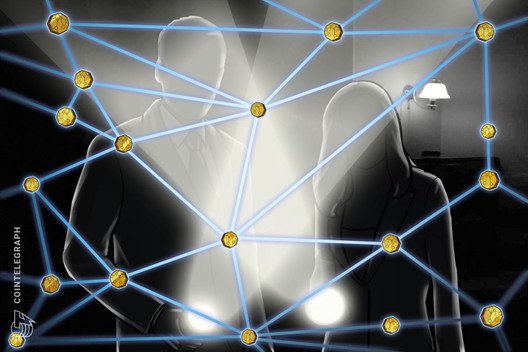Centralized vs. decentralized digital networks: Key differences
What is Bitcoin? How does blockchain work? How to mine cryptocurrency? We are glad to help you answer these questions with our quick guides in Explained section.
rn”,”seo_description”:”What is Bitcoin? How does blockchain work? How to mine cryptocurrency? We are glad to help you answer these questions with our quick guides in Explained section.”},”words_count”:836,”description”:”Find out what differentiates centralized and decentralized digital networks—and which structure is right for your organization”,”author”:{“id”:1418,”title”:”Marcel Deer”,”url”:”marcel-deer”,”twitter”:””,”google_plus”:””,”photo”:”https://s3.cointelegraph.com/storage/uploads/view/a427b150b57d0a9ad4054cf042cf01b8.jpg”,”gender”:”male”,”description”:”A qualified journalist with a background in PR and marketing, Marcel has been passionate about crypto since he first read the Cypherpunks Manifesto. As a strong believer in the power of DeFi, decentralization, and the digital economy, when he’s not writing, he’s researching the latest node projects and actively enjoying the crypto community on Twitter.”,”facebook”:””,”email”:””,”linkedin”:””,”created_at”:”2021-11-07 07:02:27″,”updated_at”:”2022-05-04 15:55:37″,”deleted_at”:null,”avatar”:”https://images.cointelegraph.com/images/150_aHR0cHM6Ly9zMy5jb2ludGVsZWdyYXBoLmNvbS9zdG9yYWdlL3VwbG9hZHMvdmlldy9hNDI3YjE1MGI1N2QwYTlhZDQwNTRjZjA0MmNmMDFiOC5qcGc=.jpg”,”hash”:”aHR0cHM6Ly9jb2ludGVsZWdyYXBoLmNvbS9hdXRob3JzL21hcmNlbC1kZWVy”,”relativeUrl”:”https://cointelegraph.com/authors/marcel-deer”,”user_id”:1418,”language_id”:1,”name”:”Marcel Deer”,”desc”:”A qualified journalist with a background in PR and marketing, Marcel has been passionate about crypto since he first read the Cypherpunks Manifesto. As a strong believer in the power of DeFi, decentralization, and the digital economy, when he’s not writing, he’s researching the latest node projects and actively enjoying the crypto community on Twitter.”,”seo_title”:””,”seo_description”:””,”enabled”:1,”show_in_authors”:0,”show_in_experts”:0},”category_id”:65,”audio”:”https://s3.cointelegraph.com/audio/87907.50fc831d-8be5-48d7-86d4-b7a9e5c0fbb3.mp3″,”tags”:[{“name”:”Blockchain”,”uri”:”/tags/blockchain”,”super”:1,”page_title”:”Blockchain News”},{“name”:”Decentralization”,”uri”:”/tags/decentralization”,”super”:0,”page_title”:”Decentralization News”}],”tag_title”:”Blockchain”,”date”:”44 MINUTES AGO”,”badge”:{“title”:”Explained”,”label”:”default”},”qty”:26,”stats_pixel”:”“,”stats_pixel_url”:”https://zoa.cointelegraph.com/pixel?postId=87907®ionId=1″,”shares”:5,”infographic”:false,”sponsored”:false,”explained”:true,”press_release”:false,”show_referral”:false,”social_description”:”Decentralized networks are a popular topic, but how are they different from their centralized counterparts? Learn the key differences between decentralized and centralized networks, along with which one is right for your organization.”,”social_translators”:{“clipboard_popup_label”:”Link copied”,”socialWechatFooterError”:”WeChat error”,”socialWechatFooterText”:”WeChat share”,”socialWechatHeaderText”:”WeChat share”},”social_shares”:{“post_id”:87907,”post_url”:”https://cointelegraph.com/explained/centralized-vs-decentralized-digital-networks-key-differences”,”post_titles”:{“normal”:”Centralized vs. decentralized digital networks: Key differences”,”twitter”:”Centralized vs. decentralized digital networks: Key differences”},”post_text”:{“normal”:”Centralized vs. decentralized digital networks: Key differences”,”twitter”:”Centralized vs. decentralized digital networks: Key differences https://cointelegraph.com/explained/centralized-vs-decentralized-digital-networks-key-differences via @cointelegraph”},”accounts”:{“twitter”:”@cointelegraph”}},”socials”:{“facebook”:{“url”:”https://www.facebook.com/sharer/sharer.php?u=https%3A%2F%2Fcointelegraph.com%2Fexplained%2Fcentralized-vs-decentralized-digital-networks-key-differences”,”count”:null,”short”:”fb”,”fa”:”facebook”},”twitter”:{“url”:”https://twitter.com/intent/tweet?text=Centralized+vs.+decentralized+digital+networks%3A+Key+differences https%3A%2F%2Fcointelegraph.com%2Fexplained%2Fcentralized-vs-decentralized-digital-networks-key-differences via @cointelegraph”,”count”:null,”short”:”tw”,”fa”:”twitter”},”telegram”:{“url”:”https://telegram.me/share/url?url=https%3A%2F%2Fcointelegraph.com%2Fexplained%2Fcentralized-vs-decentralized-digital-networks-key-differences &text=Centralized+vs.+decentralized+digital+networks%3A+Key+differences”,”count”:null,”short”:”tg”,”fa”:”paper-plane”},”whatsapp”:{“url”:”https://api.whatsapp.com/send?text=Centralized+vs.+decentralized+digital+networks%3A+Key+differences&href=https%3A%2F%2Fcointelegraph.com%2Fexplained%2Fcentralized-vs-decentralized-digital-networks-key-differences”,”count”:null,”short”:”wu”,”fa”:”whatsapp”},”gplus”:{“url”:”https://plus.google.com/share?url=https%3A%2F%2Fcointelegraph.com%2Fexplained%2Fcentralized-vs-decentralized-digital-networks-key-differences”,”count”:null,”short”:”gplus”,”fa”:”google-plus”},”reddit”:{“url”:”https://www.reddit.com/submit?url=https%3A%2F%2Fcointelegraph.com%2Fexplained%2Fcentralized-vs-decentralized-digital-networks-key-differences&title=Centralized+vs.+decentralized+digital+networks%3A+Key+differences”,”count”:null,”short”:”reddit”,”fa”:”reddit-alien”},”linkedin”:{“url”:”https://www.linkedin.com/shareArticle?mini=true&url=https%3A%2F%2Fcointelegraph.com%2Fexplained%2Fcentralized-vs-decentralized-digital-networks-key-differences&title=Centralized+vs.+decentralized+digital+networks%3A+Key+differences”,”count”:null,”short”:”li”,”fa”:”linkedin”}},”hide_disclaimer”:false,”elink”:”https://cointelegraph.com”,”etitle”:”Cointelegraph”,”elogo_x2″:”https://images.cointelegraph.com/images/528_aHR0cHM6Ly9zMy5jb2ludGVsZWdyYXBoLmNvbS9zdG9yYWdlL3VwbG9hZHMvdmlldy9hYjAzYTJhMmNlOWEyMWRjMWYwOTYxZDkxNzMxYzhiYS5wbmc=.png”,”elogo_x1″:”https://images.cointelegraph.com/images/260_aHR0cHM6Ly9zMy5jb2ludGVsZWdyYXBoLmNvbS9zdG9yYWdlL3VwbG9hZHMvdmlldy9hYjAzYTJhMmNlOWEyMWRjMWYwOTYxZDkxNzMxYzhiYS5wbmc=.png”,”elogo_svg”:false,”content”:[{“id”:3483,”post_id”:87907,”title”:”What are centralized networks?”,”content”:”
A centralized digital network is one in which a central authority controls the network.
nn
The authority may be an individual, a group of individuals or a corporation. Usually, the centralized authority is responsible for maintaining the network, managing users, and setting rules and regulations.
nn
A centralized network’s architecture is built around a single server where all significant processes are run. If the server fails, the network goes down. Many digital platforms that we interact with daily, like Facebook and YouTube, are centralized. In these examples, a single entity (the company) is in charge of all the data and processes on the network.
nnn”,”created_at”:”2022-06-11 14:05:55″,”updated_at”:”2022-06-11 14:10:05″,”sort”:1,”translations”:{“id”:3476,”explained_post_id”:3483,”title_en”:”What are centralized networks?”,”content_en”:”
A centralized digital network is one in which a central authority controls the network.
nn
The authority may be an individual, a group of individuals or a corporation. Usually, the centralized authority is responsible for maintaining the network, managing users, and setting rules and regulations.
nn
A centralized network’s architecture is built around a single server where all significant processes are run. If the server fails, the network goes down. Many digital platforms that we interact with daily, like Facebook and YouTube, are centralized. In these examples, a single entity (the company) is in charge of all the data and processes on the network.
nnn”,”title_es”:””,”content_es”:”n”,”title_cn”:””,”content_cn”:”n”,”title_de”:””,”content_de”:”n”,”title_fr”:””,”content_fr”:”n”,”title_it”:””,”content_it”:”n”,”title_ar”:””,”content_ar”:”n”,”title_br”:””,”content_br”:”n”,”title_jp”:””,”content_jp”:”n”,”created_at”:”2022-06-11 14:05:55″,”updated_at”:”2022-06-11 14:10:05″,”title_kr”:””,”content_kr”:”n”,”title_tr”:””,”content_tr”:”n”}},{“id”:3484,”post_id”:87907,”title”:”How does a centralized network work?”,”content”:”
In a centralized network, a central server handles major data processing and network management functions.
nn
This server is responsible for storing all the data and running all the processes on the network. It may be situated in a single location or spread out over multiple locations.
nn
Workstations within the network, which have less processing power, connect to the central server. Instead of directly performing specific functions (data storage, applications, utilities), these workstations submit their requests to the main server for processing.
nn
The central server typically features a robust computing power and a huge storage capacity. It also has a high-speed connection to the internet. These allow for handling a large number of users and a lot of data traffic.
nnn”,”created_at”:”2022-06-11 14:06:19″,”updated_at”:”2022-06-11 14:10:05″,”sort”:2,”translations”:{“id”:3477,”explained_post_id”:3484,”title_en”:”How does a centralized network work?”,”content_en”:”
In a centralized network, a central server handles major data processing and network management functions.
nn
This server is responsible for storing all the data and running all the processes on the network. It may be situated in a single location or spread out over multiple locations.
nn
Workstations within the network, which have less processing power, connect to the central server. Instead of directly performing specific functions (data storage, applications, utilities), these workstations submit their requests to the main server for processing.
nn
The central server typically features a robust computing power and a huge storage capacity. It also has a high-speed connection to the internet. These allow for handling a large number of users and a lot of data traffic.
nnn”,”title_es”:””,”content_es”:”n”,”title_cn”:””,”content_cn”:”n”,”title_de”:””,”content_de”:”n”,”title_fr”:””,”content_fr”:”n”,”title_it”:””,”content_it”:”n”,”title_ar”:””,”content_ar”:”n”,”title_br”:””,”content_br”:”n”,”title_jp”:””,”content_jp”:”n”,”created_at”:”2022-06-11 14:06:19″,”updated_at”:”2022-06-11 14:10:05″,”title_kr”:””,”content_kr”:”n”,”title_tr”:””,”content_tr”:”n”}},{“id”:3485,”post_id”:87907,”title”:”What are decentralized networks?”,”content”:”
A decentralized digital network is not controlled by a central authority.
nn
Instead, control is distributed among its users. There is no single server or point of command. Rather, the network is run on a peer-to-peer basis, with each user wielding equal power and responsibility.
nn
A great example of a decentralized network is the internet, itself, which is not controlled by one authority. Rather, it is distributed among its users. However, some argue that the internet is moving toward centralization due to the monopoly of big names within the space—Google, Facebook, WordPress and the like.
nn
How so? Data is concentrated within these big players’ servers. As such, everything one needs to access online goes through any one of them. So to answer the question, “Is the internet centralized or decentralized?”
nn
nTechnically, it’s decentralized, but the argument that it is slowly but surely becoming more centralized cannot be downplayed or understated.
nn
Another example is Bitcoin (BTC), the first cryptocurrency. Bitcoin’s network architecture was born after the Great Financial Crisis of 2007–2008. Briefly put, Bitcoin was launched as a decentralized network precisely because centralized institutions (banks, financial firms) “had failed the people.”
nn
The creator(s) of Bitcoin realized that if a single point of control or failure exists, the entire financial system is at risk. Therefore, they designed Bitcoin to be decentralized and distributed. No single entity or group controls it. Instead, it is managed by its users.
nnn”,”created_at”:”2022-06-11 14:06:50″,”updated_at”:”2022-06-11 14:10:05″,”sort”:3,”translations”:{“id”:3478,”explained_post_id”:3485,”title_en”:”What are decentralized networks?”,”content_en”:”
A decentralized digital network is not controlled by a central authority.
nn
Instead, control is distributed among its users. There is no single server or point of command. Rather, the network is run on a peer-to-peer basis, with each user wielding equal power and responsibility.
nn
A great example of a decentralized network is the internet, itself, which is not controlled by one authority. Rather, it is distributed among its users. However, some argue that the internet is moving toward centralization due to the monopoly of big names within the space—Google, Facebook, WordPress and the like.
nn
How so? Data is concentrated within these big players’ servers. As such, everything one needs to access online goes through any one of them. So to answer the question, “Is the internet centralized or decentralized?”
nn
nTechnically, it’s decentralized, but the argument that it is slowly but surely becoming more centralized cannot be downplayed or understated.
nn
Another example is Bitcoin (BTC), the first cryptocurrency. Bitcoin’s network architecture was born after the Great Financial Crisis of 2007–2008. Briefly put, Bitcoin was launched as a decentralized network precisely because centralized institutions (banks, financial firms) “had failed the people.”
nn
The creator(s) of Bitcoin realized that if a single point of control or failure exists, the entire financial system is at risk. Therefore, they designed Bitcoin to be decentralized and distributed. No single entity or group controls it. Instead, it is managed by its users.
nnn”,”title_es”:””,”content_es”:”n”,”title_cn”:””,”content_cn”:”n”,”title_de”:””,”content_de”:”n”,”title_fr”:””,”content_fr”:”n”,”title_it”:””,”content_it”:”n”,”title_ar”:””,”content_ar”:”n”,”title_br”:””,”content_br”:”n”,”title_jp”:””,”content_jp”:”n”,”created_at”:”2022-06-11 14:06:50″,”updated_at”:”2022-06-11 14:10:05″,”title_kr”:””,”content_kr”:”n”,”title_tr”:””,”content_tr”:”n”}},{“id”:3486,”post_id”:87907,”title”:”How does a decentralized network work?”,”content”:”
Rather than rely on a single central server, a decentralized network distributes information-processing tasks across multiple devices.
nn
In a decentralized network, even if one of the master nodes fails or is attacked, the remaining servers may continue to grant data access to users. Consequently, the overall network will continue to work without disruption.
nn
Recent technological advancements have endowed computers and other devices with large amounts of processing power, which can be synced and used for decentralized computing. This is what makes decentralized networks possible.
nn
It’s essential to remember that while decentralized networks are distinct from centralized networks, they are still reliant on main servers, although in more than one per network.
nnn”,”created_at”:”2022-06-11 14:07:11″,”updated_at”:”2022-06-11 14:10:05″,”sort”:4,”translations”:{“id”:3479,”explained_post_id”:3486,”title_en”:”How does a decentralized network work?”,”content_en”:”
Rather than rely on a single central server, a decentralized network distributes information-processing tasks across multiple devices.
nn
In a decentralized network, even if one of the master nodes fails or is attacked, the remaining servers may continue to grant data access to users. Consequently, the overall network will continue to work without disruption.
nn
Recent technological advancements have endowed computers and other devices with large amounts of processing power, which can be synced and used for decentralized computing. This is what makes decentralized networks possible.
nn
It’s essential to remember that while decentralized networks are distinct from centralized networks, they are still reliant on main servers, although in more than one per network.
nnn”,”title_es”:””,”content_es”:”n”,”title_cn”:””,”content_cn”:”n”,”title_de”:””,”content_de”:”n”,”title_fr”:””,”content_fr”:”n”,”title_it”:””,”content_it”:”n”,”title_ar”:””,”content_ar”:”n”,”title_br”:””,”content_br”:”n”,”title_jp”:””,”content_jp”:”n”,”created_at”:”2022-06-11 14:07:11″,”updated_at”:”2022-06-11 14:10:05″,”title_kr”:””,”content_kr”:”n”,”title_tr”:””,”content_tr”:”n”}},{“id”:3487,”post_id”:87907,”title”:”The basic difference between centralized and decentralized networks”,”content”:”
Aside from the locus of control, the key differences between centralized and decentralized networks inextricably lie in what they stand for.
nn
Simply put, a centralized network is used to maintain control and stability. In contrast, a decentralized network is geared toward user freedom and collaboration.
nn
If you’re in the mood to get into the philosophical and theoretical underpinnings of centralization vs. decentralization, we have a great thought piece on that here.
nn
In the meantime, let’s dive into the basic differences between the two:
nn
- nt
- Third-party involvement: In a centralized network, a third party or middleman is required to facilitate communication between different nodes. There is no need for a third party in a decentralized network. Each node can communicate directly with every other node on the network.
- Transparency: Centralized networks are less transparent because all data and information are stored in one central location. Decentralization, however, increases transparency through distributed ledger technology (DLT).
- Security: Centralized networks are more vulnerable to attacks as hackers only need to target one central point to gain access to the entire system. Decentralized networks are more secure because even if one node is compromised, the others are not affected.
- Scalability: Centralized networks are easier to scale just by adding more servers to the system. This is more difficult to pull off with decentralized networks since each of their nodes needs to be capable of handling more traffic.
- Exchange fees: Centralized networks tend to have higher fees (think of banks and financial services) as more middlemen are involved in the process. Such actors are not present in decentralized networks, resulting in lower fees.
nt
nt
nt
nt
n
nn

nnn”,”created_at”:”2022-06-11 14:08:42″,”updated_at”:”2022-06-11 14:10:04″,”sort”:5,”translations”:{“id”:3480,”explained_post_id”:3487,”title_en”:”The basic difference between centralized and decentralized networks”,”content_en”:”
Aside from the locus of control, the key differences between centralized and decentralized networks inextricably lie in what they stand for.
nn
Simply put, a centralized network is used to maintain control and stability. In contrast, a decentralized network is geared toward user freedom and collaboration.
nn
If you’re in the mood to get into the philosophical and theoretical underpinnings of centralization vs. decentralization, we have a great thought piece on that here.
nn
In the meantime, let’s dive into the basic differences between the two:
nn
- nt
- Third-party involvement: In a centralized network, a third party or middleman is required to facilitate communication between different nodes. There is no need for a third party in a decentralized network. Each node can communicate directly with every other node on the network.
- Transparency: Centralized networks are less transparent because all data and information are stored in one central location. Decentralization, however, increases transparency through distributed ledger technology (DLT).
- Security: Centralized networks are more vulnerable to attacks as hackers only need to target one central point to gain access to the entire system. Decentralized networks are more secure because even if one node is compromised, the others are not affected.
- Scalability: Centralized networks are easier to scale just by adding more servers to the system. This is more difficult to pull off with decentralized networks since each of their nodes needs to be capable of handling more traffic.
- Exchange fees: Centralized networks tend to have higher fees (think of banks and financial services) as more middlemen are involved in the process. Such actors are not present in decentralized networks, resulting in lower fees.
nt
nt
nt
nt
n
nn

nnn”,”title_es”:””,”content_es”:”n”,”title_cn”:””,”content_cn”:”n”,”title_de”:””,”content_de”:”n”,”title_fr”:””,”content_fr”:”n”,”title_it”:””,”content_it”:”n”,”title_ar”:””,”content_ar”:”n”,”title_br”:””,”content_br”:”n”,”title_jp”:””,”content_jp”:”n”,”created_at”:”2022-06-11 14:08:42″,”updated_at”:”2022-06-11 14:10:04″,”title_kr”:””,”content_kr”:”n”,”title_tr”:””,”content_tr”:”n”}},{“id”:3488,”post_id”:87907,”title”:”Advantages of centralized and decentralized networks”,”content”:”
The merits of a centralized network are a clear chain of command, inexpensive setup and easier task delegation. Decentralized networks, on the other hand, are immutable, censorship-resistant and provide users with complete control and security.
nn
There is a clear chain of command in a centralized network, and everyone knows who is in charge. This can be helpful in times of crisis when decisions need to be made quickly and efficiently.
nn
Centralized networks also tend to be less expensive to set up and maintain as only one server or mainframe needs to be managed. In addition, it is easier to delegate tasks with clear-cut lines of authority. This ensures that tasks are completed timely and efficiently.
nn
Meanwhile, in decentralized networks, users exercise complete control over their data and information. They are also immutable, i.e., once data is entered into the system, it cannot be changed or altered. This ensures data integrity and fraud prevention.
nn
Another pro is that decentralized networks employ cryptography to guarantee the safety of data ledgers. Because the current block’s data must be validated using cryptography, it relies on data from the adjacent block, thus making the data incredibly secure.
nn
Lastly, in a decentralized network, no central authority exists to censor or restrict content. This is appealing to those wanting to share information without fear of reprisal.
nnn”,”created_at”:”2022-06-11 14:09:12″,”updated_at”:”2022-06-11 14:10:04″,”sort”:6,”translations”:{“id”:3481,”explained_post_id”:3488,”title_en”:”Advantages of centralized and decentralized networks”,”content_en”:”
The merits of a centralized network are a clear chain of command, inexpensive setup and easier task delegation. Decentralized networks, on the other hand, are immutable, censorship-resistant and provide users with complete control and security.
nn
There is a clear chain of command in a centralized network, and everyone knows who is in charge. This can be helpful in times of crisis when decisions need to be made quickly and efficiently.
nn
Centralized networks also tend to be less expensive to set up and maintain as only one server or mainframe needs to be managed. In addition, it is easier to delegate tasks with clear-cut lines of authority. This ensures that tasks are completed timely and efficiently.
nn
Meanwhile, in decentralized networks, users exercise complete control over their data and information. They are also immutable, i.e., once data is entered into the system, it cannot be changed or altered. This ensures data integrity and fraud prevention.
nn
Another pro is that decentralized networks employ cryptography to guarantee the safety of data ledgers. Because the current block’s data must be validated using cryptography, it relies on data from the adjacent block, thus making the data incredibly secure.
nn
Lastly, in a decentralized network, no central authority exists to censor or restrict content. This is appealing to those wanting to share information without fear of reprisal.
nnn”,”title_es”:””,”content_es”:”n”,”title_cn”:””,”content_cn”:”n”,”title_de”:””,”content_de”:”n”,”title_fr”:””,”content_fr”:”n”,”title_it”:””,”content_it”:”n”,”title_ar”:””,”content_ar”:”n”,”title_br”:””,”content_br”:”n”,”title_jp”:””,”content_jp”:”n”,”created_at”:”2022-06-11 14:09:12″,”updated_at”:”2022-06-11 14:10:04″,”title_kr”:””,”content_kr”:”n”,”title_tr”:””,”content_tr”:”n”}},{“id”:3489,”post_id”:87907,”title”:”Disadvantages of centralized and decentralized networks”,”content”:”
Censorship, limited scalability and security issues are some of the downsides of centralized networks. Meanwhile, lack of clarity, high setup and maintenance costs, and volatility are the weak points of decentralized networks.
nn
In a centralized system, there is often a single point of failure. If the central authority is compromised, it can bring down the entire system — a major disadvantage, especially in systems where security is critical.
nn
As for scalability, a centralized system can often only grow as fast as the central authority allows it. Restrictive development could be disheartening when users are clamoring for more features and functionality.
nn
Censorship is another disadvantage. In a centralized system, the central authority has the power to restrict content. This is a major con for those looking to share information freely.
nn
However, in a decentralized system, lack of clarity can often be an issue. Since decentralized network governance doesn’t rely on key authorities, such a structure could be its undoing in times of crisis when decisions need to be made quickly.
nn
Decentralized systems are also more expensive to set up and manage since they need systems with automated communication capabilities.
nn
And lastly, the prices of decentralized digital currency are known to be volatile, making them a risky endeavor for more conservative investors.
nnn”,”created_at”:”2022-06-11 14:09:35″,”updated_at”:”2022-06-11 14:10:04″,”sort”:7,”translations”:{“id”:3482,”explained_post_id”:3489,”title_en”:”Disadvantages of centralized and decentralized networks”,”content_en”:”
Censorship, limited scalability and security issues are some of the downsides of centralized networks. Meanwhile, lack of clarity, high setup and maintenance costs, and volatility are the weak points of decentralized networks.
nn
In a centralized system, there is often a single point of failure. If the central authority is compromised, it can bring down the entire system — a major disadvantage, especially in systems where security is critical.
nn
As for scalability, a centralized system can often only grow as fast as the central authority allows it. Restrictive development could be disheartening when users are clamoring for more features and functionality.
nn
Censorship is another disadvantage. In a centralized system, the central authority has the power to restrict content. This is a major con for those looking to share information freely.
nn
However, in a decentralized system, lack of clarity can often be an issue. Since decentralized network governance doesn’t rely on key authorities, such a structure could be its undoing in times of crisis when decisions need to be made quickly.
nn
Decentralized systems are also more expensive to set up and manage since they need systems with automated communication capabilities.
nn
And lastly, the prices of decentralized digital currency are known to be volatile, making them a risky endeavor for more conservative investors.
nnn”,”title_es”:””,”content_es”:”n”,”title_cn”:””,”content_cn”:”n”,”title_de”:””,”content_de”:”n”,”title_fr”:””,”content_fr”:”n”,”title_it”:””,”content_it”:”n”,”title_ar”:””,”content_ar”:”n”,”title_br”:””,”content_br”:”n”,”title_jp”:””,”content_jp”:”n”,”created_at”:”2022-06-11 14:09:35″,”updated_at”:”2022-06-11 14:10:04″,”title_kr”:””,”content_kr”:”n”,”title_tr”:””,”content_tr”:”n”}}],”is_partner_material”:false,”commentsSection”:{“schemaEntityUrl”:”//cointelegraph.com/explained/centralized-vs-decentralized-digital-networks-key-differences”,”list”:[],”amount”:0,”i18n”:{“addComment”:”Add a comment…”,”amountOnePostfix”:”Comment”,”amountPostfix”:”Comments”,”cancel”:”Cancel”,”delete”:”Delete”,”edit”:”Edit”,”errorBig”:”Comment text cannot be longer than 2000 characters”,”errorDuplicate”:”Duplicate comment”,”errorSmall”:”Comment text must be at least 2 characters long”,”hideButton”:”Hide comments”,”noComments”:” “,”commentOnModeration”:”Comment on moderation”,”postComment”:”Post”,”reply”:”Reply”,”showAllComments”:”Show All Comments”,”showButtonPostfix”:”comments”,”showButtonPrefix”:”Show”,”signIn”:”Sign in”,”update”:”Update comment”,”commentWasDeleted”:”This comment has been deleted”}},”related”:[{“id”:46588,”retina”:”https://images.cointelegraph.com/images/1480_aHR0cHM6Ly9zMy5jb2ludGVsZWdyYXBoLmNvbS9zdG9yYWdlL3VwbG9hZHMvdmlldy9lNGIxZDQ2ODQwNDY0NmVjNzcwMWMyOGZlY2JiZmIwNC5qcGc=.jpg”,”img”:”https://images.cointelegraph.com/images/740_aHR0cHM6Ly9zMy5jb2ludGVsZWdyYXBoLmNvbS9zdG9yYWdlL3VwbG9hZHMvdmlldy9lNGIxZDQ2ODQwNDY0NmVjNzcwMWMyOGZlY2JiZmIwNC5qcGc=.jpg”,”thumb”:”https://images.cointelegraph.com/images/370_aHR0cHM6Ly9zMy5jb2ludGVsZWdyYXBoLmNvbS9zdG9yYWdlL3VwbG9hZHMvdmlldy9lNGIxZDQ2ODQwNDY0NmVjNzcwMWMyOGZlY2JiZmIwNC5qcGc=.jpg”,”thumb370″:”https://images.cointelegraph.com/images/370_aHR0cHM6Ly9zMy5jb2ludGVsZWdyYXBoLmNvbS9zdG9yYWdlL3VwbG9hZHMvdmlldy9lNGIxZDQ2ODQwNDY0NmVjNzcwMWMyOGZlY2JiZmIwNC5qcGc=.jpg”,”amp_thumb”:”https://images.cointelegraph.com/images/150_aHR0cHM6Ly9zMy5jb2ludGVsZWdyYXBoLmNvbS9zdG9yYWdlL3VwbG9hZHMvdmlldy9lNGIxZDQ2ODQwNDY0NmVjNzcwMWMyOGZlY2JiZmIwNC5qcGc=.jpg”,”thumb150″:”https://images.cointelegraph.com/images/150_aHR0cHM6Ly9zMy5jb2ludGVsZWdyYXBoLmNvbS9zdG9yYWdlL3VwbG9hZHMvdmlldy9lNGIxZDQ2ODQwNDY0NmVjNzcwMWMyOGZlY2JiZmIwNC5qcGc=.jpg”,”url”:”https://cointelegraph.com/news/crypto-crime-on-the-rise-good-odds-of-2020-becoming-a-record-breaker”,”title”:”Crypto Crime on the Rise — Good Odds of 2020 Becoming a Record-Breaker”,”lead”:”Experts believe that a more holistic crypto ecosystem, especially one that is more AML-centric, is needed to help prevent the spread of crypto scams in 2020.”,”leadfull”:””,”category_id”:19,”category_url”:”https://cointelegraph.com/category/analysis”,”category_title”:”Analysis”,”author_url”:”https://cointelegraph.com/authors/shiraz-jagati”,”author_hash”:”aHR0cHM6Ly9jb2ludGVsZWdyYXBoLmNvbS9hdXRob3JzL3NoaXJhei1qYWdhdGk=”,”author_title”:”Shiraz Jagati”,”author_img”:”https://images.cointelegraph.com/images/32_aHR0cHM6Ly9zMy5jb2ludGVsZWdyYXBoLmNvbS9zdG9yYWdlL3VwbG9hZHMvdmlldy80NWFkZTVhZDI3NmQyOGMwNjZhMjA2NGE1MTc1ZDNhMy5qcGc=.jpg”,”date”:”JUN 07, 2020″,”flash_date”:”JUN 07, 2020″,”sponsored”:false,”press_release”:false,”sponsored_label”:”Sponsored”,”explained”:false,”badge”:{“title”:”Analysis”,”label”:”info”},”published”:{“date”:”2020-06-07 09:00:00.000000″,”timezone_type”:3,”timezone”:”Europe/London”},”stat_uniqs”:82563,”rss_date”:”Sun, 07 Jun 2020 09:00:00 +0100″,”publishedW3″:”2020-06-07T09:00:00+01:00″,”show_referral”:true,”isMagazine”:false},{“id”:87491,”retina”:”https://images.cointelegraph.com/images/1480_aHR0cHM6Ly9zMy5jb2ludGVsZWdyYXBoLmNvbS9zdG9yYWdlL3VwbG9hZHMvdmlldy8zMjYwMzYwNDMxMDJjZDlkZmQ0Nzg2YThhNjM0NGU0Ny5qcGc=.jpg”,”img”:”https://images.cointelegraph.com/images/740_aHR0cHM6Ly9zMy5jb2ludGVsZWdyYXBoLmNvbS9zdG9yYWdlL3VwbG9hZHMvdmlldy8zMjYwMzYwNDMxMDJjZDlkZmQ0Nzg2YThhNjM0NGU0Ny5qcGc=.jpg”,”thumb”:”https://images.cointelegraph.com/images/370_aHR0cHM6Ly9zMy5jb2ludGVsZWdyYXBoLmNvbS9zdG9yYWdlL3VwbG9hZHMvdmlldy8zMjYwMzYwNDMxMDJjZDlkZmQ0Nzg2YThhNjM0NGU0Ny5qcGc=.jpg”,”thumb370″:”https://images.cointelegraph.com/images/370_aHR0cHM6Ly9zMy5jb2ludGVsZWdyYXBoLmNvbS9zdG9yYWdlL3VwbG9hZHMvdmlldy8zMjYwMzYwNDMxMDJjZDlkZmQ0Nzg2YThhNjM0NGU0Ny5qcGc=.jpg”,”amp_thumb”:”https://images.cointelegraph.com/images/150_aHR0cHM6Ly9zMy5jb2ludGVsZWdyYXBoLmNvbS9zdG9yYWdlL3VwbG9hZHMvdmlldy8zMjYwMzYwNDMxMDJjZDlkZmQ0Nzg2YThhNjM0NGU0Ny5qcGc=.jpg”,”thumb150″:”https://images.cointelegraph.com/images/150_aHR0cHM6Ly9zMy5jb2ludGVsZWdyYXBoLmNvbS9zdG9yYWdlL3VwbG9hZHMvdmlldy8zMjYwMzYwNDMxMDJjZDlkZmQ0Nzg2YThhNjM0NGU0Ny5qcGc=.jpg”,”url”:”https://cointelegraph.com/news/qa-renowned-ai-artist-cslim-on-nft-use-cases-rethinking-rarity-and-whether-the-market-is-in-decline”,”title”:”Q&A: Renowned AI artist CSLIM on NFT use cases, rethinking rarity, and whether the market is in decline”,”lead”:”South Korean artist CSLIM has created an ecosystem surrounding his NFTs — with a thousand of supporters subscribing.”,”leadfull”:””,”category_id”:62,”category_url”:”https://cointelegraph.com/category/sponsored”,”category_title”:”Sponsored”,”author_url”:”https://cointelegraph.com/authors/sarah-jansen”,”author_hash”:”aHR0cHM6Ly9jb2ludGVsZWdyYXBoLmNvbS9hdXRob3JzL3NhcmFoLWphbnNlbg==”,”author_title”:”Sarah Jansen”,”author_img”:”https://images.cointelegraph.com/images/32_aHR0cHM6Ly9zMy5jb2ludGVsZWdyYXBoLmNvbS9zdG9yYWdlL3VwbG9hZHMvdmlldy84N2IwYjRjMzkyZjlhYmM4ZjlhZDNiZTU3Y2FjZGJmZC5qcGc=.jpg”,”date”:”JUN 06, 2022″,”flash_date”:”JUN 06, 2022″,”sponsored”:true,”press_release”:false,”sponsored_label”:”Sponsored”,”explained”:false,”badge”:{“title”:”Sponsored”,”label”:”default”},”published”:{“date”:”2022-06-06 13:00:00.000000″,”timezone_type”:3,”timezone”:”Europe/London”},”stat_uniqs”:755,”rss_date”:”Mon, 06 Jun 2022 13:00:00 +0100″,”publishedW3″:”2022-06-06T13:00:00+01:00″,”show_referral”:true,”isMagazine”:false},{“id”:87096,”retina”:”https://images.cointelegraph.com/images/1480_aHR0cHM6Ly9zMy5jb2ludGVsZWdyYXBoLmNvbS91cGxvYWRzLzIwMjItMDUvZmZiMzFmNmUtYzI1NS00Yzc3LTgxMjgtYTZiMTk4NTRhMTQxLmpwZw==.jpg”,”img”:”https://images.cointelegraph.com/images/740_aHR0cHM6Ly9zMy5jb2ludGVsZWdyYXBoLmNvbS91cGxvYWRzLzIwMjItMDUvZmZiMzFmNmUtYzI1NS00Yzc3LTgxMjgtYTZiMTk4NTRhMTQxLmpwZw==.jpg”,”thumb”:”https://images.cointelegraph.com/images/370_aHR0cHM6Ly9zMy5jb2ludGVsZWdyYXBoLmNvbS91cGxvYWRzLzIwMjItMDUvZmZiMzFmNmUtYzI1NS00Yzc3LTgxMjgtYTZiMTk4NTRhMTQxLmpwZw==.jpg”,”thumb370″:”https://images.cointelegraph.com/images/370_aHR0cHM6Ly9zMy5jb2ludGVsZWdyYXBoLmNvbS91cGxvYWRzLzIwMjItMDUvZmZiMzFmNmUtYzI1NS00Yzc3LTgxMjgtYTZiMTk4NTRhMTQxLmpwZw==.jpg”,”amp_thumb”:”https://images.cointelegraph.com/images/150_aHR0cHM6Ly9zMy5jb2ludGVsZWdyYXBoLmNvbS91cGxvYWRzLzIwMjItMDUvZmZiMzFmNmUtYzI1NS00Yzc3LTgxMjgtYTZiMTk4NTRhMTQxLmpwZw==.jpg”,”thumb150″:”https://images.cointelegraph.com/images/150_aHR0cHM6Ly9zMy5jb2ludGVsZWdyYXBoLmNvbS91cGxvYWRzLzIwMjItMDUvZmZiMzFmNmUtYzI1NS00Yzc3LTgxMjgtYTZiMTk4NTRhMTQxLmpwZw==.jpg”,”url”:”https://cointelegraph.com/news/is-there-a-secure-future-for-cross-chain-bridges”,”title”:”Is there a secure future for cross-chain bridges?”,”lead”:”For all the flak they have been getting recently, cross-chain bridges bring too much value to the blockchain space to ditch them.”,”leadfull”:””,”category_id”:81,”category_url”:”https://cointelegraph.com/category/opinion”,”category_title”:”Opinion “,”author_url”:”https://cointelegraph.com/authors/lior-lamesh”,”author_hash”:”aHR0cHM6Ly9jb2ludGVsZWdyYXBoLmNvbS9hdXRob3JzL2xpb3ItbGFtZXNo”,”author_title”:”Lior Lamesh”,”author_img”:”https://cointelegraph.com/assets/img/icons/author_male.jpg”,”date”:”MAY 29, 2022″,”flash_date”:”MAY 29, 2022″,”sponsored”:false,”press_release”:false,”sponsored_label”:”Sponsored”,”explained”:false,”badge”:{“title”:”Opinion”,”label”:”success”},”published”:{“date”:”2022-05-29 03:17:00.000000″,”timezone_type”:3,”timezone”:”Europe/London”},”stat_uniqs”:4991,”rss_date”:”Sun, 29 May 2022 03:17:00 +0100″,”publishedW3″:”2022-05-29T03:17:00+01:00″,”show_referral”:true,”isMagazine”:false},{“id”:87368,”retina”:”https://images.cointelegraph.com/images/1480_aHR0cHM6Ly9zMy5jb2ludGVsZWdyYXBoLmNvbS91cGxvYWRzLzIwMjItMDUvNWUxODNmM2MtN2VjYy00ZWViLWIyNDctNDYxZDc5MWNlYWEyLmpwZw==.jpg”,”img”:”https://images.cointelegraph.com/images/740_aHR0cHM6Ly9zMy5jb2ludGVsZWdyYXBoLmNvbS91cGxvYWRzLzIwMjItMDUvNWUxODNmM2MtN2VjYy00ZWViLWIyNDctNDYxZDc5MWNlYWEyLmpwZw==.jpg”,”thumb”:”https://images.cointelegraph.com/images/370_aHR0cHM6Ly9zMy5jb2ludGVsZWdyYXBoLmNvbS91cGxvYWRzLzIwMjItMDUvNWUxODNmM2MtN2VjYy00ZWViLWIyNDctNDYxZDc5MWNlYWEyLmpwZw==.jpg”,”thumb370″:”https://images.cointelegraph.com/images/370_aHR0cHM6Ly9zMy5jb2ludGVsZWdyYXBoLmNvbS91cGxvYWRzLzIwMjItMDUvNWUxODNmM2MtN2VjYy00ZWViLWIyNDctNDYxZDc5MWNlYWEyLmpwZw==.jpg”,”amp_thumb”:”https://images.cointelegraph.com/images/150_aHR0cHM6Ly9zMy5jb2ludGVsZWdyYXBoLmNvbS91cGxvYWRzLzIwMjItMDUvNWUxODNmM2MtN2VjYy00ZWViLWIyNDctNDYxZDc5MWNlYWEyLmpwZw==.jpg”,”thumb150″:”https://images.cointelegraph.com/images/150_aHR0cHM6Ly9zMy5jb2ludGVsZWdyYXBoLmNvbS91cGxvYWRzLzIwMjItMDUvNWUxODNmM2MtN2VjYy00ZWViLWIyNDctNDYxZDc5MWNlYWEyLmpwZw==.jpg”,”url”:”https://cointelegraph.com/news/anonymous-culture-in-crypto-may-be-losing-its-relevance”,”title”:”Anonymous culture in crypto may be losing its relevance “,”lead”:”Although anonymous teams have built some of the leading infrastructure in crypto, many new participants in the ecosystem are using their real identities. “,”leadfull”:””,”category_id”:19,”category_url”:”https://cointelegraph.com/category/analysis”,”category_title”:”Analysis”,”author_url”:”https://cointelegraph.com/authors/inigo-vaca”,”author_hash”:”aHR0cHM6Ly9jb2ludGVsZWdyYXBoLmNvbS9hdXRob3JzL2luaWdvLXZhY2E=”,”author_title”:”Inigo Vaca”,”author_img”:”https://images.cointelegraph.com/images/32_aHR0cHM6Ly9zMy5jb2ludGVsZWdyYXBoLmNvbS9zdG9yYWdlL3VwbG9hZHMvdmlldy8yMGRhMTA1ZTQxN2QzMzU5ZWFlYThlY2ZhMzk5OWZlZC5qcGc=.jpg”,”date”:”JUN 01, 2022″,”flash_date”:”JUN 01, 2022″,”sponsored”:false,”press_release”:false,”sponsored_label”:”Sponsored”,”explained”:false,”badge”:{“title”:”Analysis”,”label”:”info”},”published”:{“date”:”2022-06-01 16:00:00.000000″,”timezone_type”:3,”timezone”:”Europe/London”},”stat_uniqs”:3234,”rss_date”:”Wed, 01 Jun 2022 16:00:00 +0100″,”publishedW3″:”2022-06-01T16:00:00+01:00″,”show_referral”:true,”isMagazine”:false},{“id”:87486,”retina”:”https://images.cointelegraph.com/images/1480_aHR0cHM6Ly9zMy5jb2ludGVsZWdyYXBoLmNvbS91cGxvYWRzLzIwMjItMDUvYjM2NWRjOGQtOTk2YS00MDY1LThiMDEtZjVkYjYwZWQ0NTgzLmpwZw==.jpg”,”img”:”https://images.cointelegraph.com/images/740_aHR0cHM6Ly9zMy5jb2ludGVsZWdyYXBoLmNvbS91cGxvYWRzLzIwMjItMDUvYjM2NWRjOGQtOTk2YS00MDY1LThiMDEtZjVkYjYwZWQ0NTgzLmpwZw==.jpg”,”thumb”:”https://images.cointelegraph.com/images/370_aHR0cHM6Ly9zMy5jb2ludGVsZWdyYXBoLmNvbS91cGxvYWRzLzIwMjItMDUvYjM2NWRjOGQtOTk2YS00MDY1LThiMDEtZjVkYjYwZWQ0NTgzLmpwZw==.jpg”,”thumb370″:”https://images.cointelegraph.com/images/370_aHR0cHM6Ly9zMy5jb2ludGVsZWdyYXBoLmNvbS91cGxvYWRzLzIwMjItMDUvYjM2NWRjOGQtOTk2YS00MDY1LThiMDEtZjVkYjYwZWQ0NTgzLmpwZw==.jpg”,”amp_thumb”:”https://images.cointelegraph.com/images/150_aHR0cHM6Ly9zMy5jb2ludGVsZWdyYXBoLmNvbS91cGxvYWRzLzIwMjItMDUvYjM2NWRjOGQtOTk2YS00MDY1LThiMDEtZjVkYjYwZWQ0NTgzLmpwZw==.jpg”,”thumb150″:”https://images.cointelegraph.com/images/150_aHR0cHM6Ly9zMy5jb2ludGVsZWdyYXBoLmNvbS91cGxvYWRzLzIwMjItMDUvYjM2NWRjOGQtOTk2YS00MDY1LThiMDEtZjVkYjYwZWQ0NTgzLmpwZw==.jpg”,”url”:”https://cointelegraph.com/news/beyond-the-hype-nfts-can-lead-the-way-in-transforming-business-experiences”,”title”:”Beyond the hype: NFTs can lead the way in transforming business experiences”,”lead”:”In the emerging decentralized Web3 economy, NFTs will enable creators to connect with and serve clients in brand new ways.”,”leadfull”:””,”category_id”:81,”category_url”:”https://cointelegraph.com/category/opinion”,”category_title”:”Opinion “,”author_url”:”https://cointelegraph.com/authors/christos-makridis”,”author_hash”:”aHR0cHM6Ly9jb2ludGVsZWdyYXBoLmNvbS9hdXRob3JzL2NocmlzdG9zLW1ha3JpZGlz”,”author_title”:”Christos Makridis”,”author_img”:”https://cointelegraph.com/assets/img/icons/author_male.jpg”,”date”:”JUN 05, 2022″,”flash_date”:”JUN 05, 2022″,”sponsored”:false,”press_release”:false,”sponsored_label”:”Sponsored”,”explained”:false,”badge”:{“title”:”Opinion”,”label”:”success”},”published”:{“date”:”2022-06-05 03:11:00.000000″,”timezone_type”:3,”timezone”:”Europe/London”},”stat_uniqs”:3203,”rss_date”:”Sun, 05 Jun 2022 03:11:00 +0100″,”publishedW3″:”2022-06-05T03:11:00+01:00″,”show_referral”:true,”isMagazine”:false},{“id”:87496,”retina”:”https://images.cointelegraph.com/images/1480_aHR0cHM6Ly9zMy5jb2ludGVsZWdyYXBoLmNvbS91cGxvYWRzLzIwMjItMDYvMTQ1MjUyMDctNTA0ZS00MDFjLThkMTUtMDNhZTcyNTAyNjQ5LmpwZw==.jpg”,”img”:”https://images.cointelegraph.com/images/740_aHR0cHM6Ly9zMy5jb2ludGVsZWdyYXBoLmNvbS91cGxvYWRzLzIwMjItMDYvMTQ1MjUyMDctNTA0ZS00MDFjLThkMTUtMDNhZTcyNTAyNjQ5LmpwZw==.jpg”,”thumb”:”https://images.cointelegraph.com/images/370_aHR0cHM6Ly9zMy5jb2ludGVsZWdyYXBoLmNvbS91cGxvYWRzLzIwMjItMDYvMTQ1MjUyMDctNTA0ZS00MDFjLThkMTUtMDNhZTcyNTAyNjQ5LmpwZw==.jpg”,”thumb370″:”https://images.cointelegraph.com/images/370_aHR0cHM6Ly9zMy5jb2ludGVsZWdyYXBoLmNvbS91cGxvYWRzLzIwMjItMDYvMTQ1MjUyMDctNTA0ZS00MDFjLThkMTUtMDNhZTcyNTAyNjQ5LmpwZw==.jpg”,”amp_thumb”:”https://images.cointelegraph.com/images/150_aHR0cHM6Ly9zMy5jb2ludGVsZWdyYXBoLmNvbS91cGxvYWRzLzIwMjItMDYvMTQ1MjUyMDctNTA0ZS00MDFjLThkMTUtMDNhZTcyNTAyNjQ5LmpwZw==.jpg”,”thumb150″:”https://images.cointelegraph.com/images/150_aHR0cHM6Ly9zMy5jb2ludGVsZWdyYXBoLmNvbS91cGxvYWRzLzIwMjItMDYvMTQ1MjUyMDctNTA0ZS00MDFjLThkMTUtMDNhZTcyNTAyNjQ5LmpwZw==.jpg”,”url”:”https://cointelegraph.com/news/terra-2-0-a-crypto-project-built-on-the-ruins-of-40-billion-in-investors-money”,”title”:”Terra 2.0: A crypto project built on the ruins of $40 billion in investors’ money “,”lead”:”Terra 2.0 launced with the promise of helping to retrieve lost funds, but early indicators suggest launching a new token to compensate for the failure of anothe…”,”leadfull”:””,”category_id”:19,”category_url”:”https://cointelegraph.com/category/analysis”,”category_title”:”Analysis”,”author_url”:”https://cointelegraph.com/authors/prashant-jha”,”author_hash”:”aHR0cHM6Ly9jb2ludGVsZWdyYXBoLmNvbS9hdXRob3JzL3ByYXNoYW50LWpoYQ==”,”author_title”:”Prashant Jha”,”author_img”:”https://images.cointelegraph.com/images/32_aHR0cHM6Ly9zMy5jb2ludGVsZWdyYXBoLmNvbS9zdG9yYWdlL3VwbG9hZHMvdmlldy9iZjk4ODk2OGFmZTBmOGU4OGEyMTdlMmEyMGM1ZmMxZS5qcGc=.jpg”,”date”:”JUN 03, 2022″,”flash_date”:”JUN 03, 2022″,”sponsored”:false,”press_release”:false,”sponsored_label”:”Sponsored”,”explained”:false,”badge”:{“title”:”Analysis”,”label”:”info”},”published”:{“date”:”2022-06-03 14:55:41.000000″,”timezone_type”:3,”timezone”:”Europe/London”},”stat_uniqs”:14531,”rss_date”:”Fri, 03 Jun 2022 14:55:41 +0100″,”publishedW3″:”2022-06-03T14:55:41+01:00″,”show_referral”:true,”isMagazine”:false}]}” :shares=”{“facebook”:{“url”:”https://www.facebook.com/sharer/sharer.php?u=%URL%”,”icon”:”facebook”,”title”:”Facebook”,”sizesAllowed”:[{“size”:”lg”,”label”:”Large devices”,”breakpoint”:”> 1200px”},{“size”:”md”,”label”:”Medium devices”,”breakpoint”:”> 992px”},{“size”:”sm”,”label”:”Small tablets”,”breakpoint”:”> 768px”},{“size”:”xs”,”label”:”Smartphones”,”breakpoint”:”> 480px”},{“size”:”xxs”,”label”:”Extra small devices”,”breakpoint”:”< 480px"}],"position":1,"status":true},"twitter":{"url":"https://twitter.com/intent/tweet?text=%TEXT%","icon":"twitter","title":"Twitter","position":2,"status":true,"sizesAllowed":[{"size":"xxs","label":"Extra small devices","breakpoint":"< 480px"},{"size":"xs","label":"Smartphones","breakpoint":"> 480px”},{“size”:”sm”,”label”:”Small tablets”,”breakpoint”:”> 768px”},{“size”:”md”,”label”:”Medium devices”,”breakpoint”:”> 992px”},{“size”:”lg”,”label”:”Large devices”,”breakpoint”:”> 1200px”}]},”telegram”:{“url”:”https://t.me/share/url?url=%URL%&text=%TEXT%”,”icon”:”telegram”,”title”:”Telegram”,”position”:3,”status”:true,”sizesAllowed”:[{“size”:”xxs”,”label”:”Extra small devices”,”breakpoint”:”< 480px"},{"size":"xs","label":"Smartphones","breakpoint":"> 480px”},{“size”:”sm”,”label”:”Small tablets”,”breakpoint”:”> 768px”},{“size”:”md”,”label”:”Medium devices”,”breakpoint”:”> 992px”},{“size”:”lg”,”label”:”Large devices”,”breakpoint”:”> 1200px”}]},”linkedin”:{“url”:”https://www.linkedin.com/shareArticle?mini=true&url=%URL%&title=%TITLE%”,”icon”:”linked-in”,”title”:”LinkedIn”,”position”:5,”status”:true,”sizesAllowed”:[{“size”:”xxs”,”label”:”Extra small devices”,”breakpoint”:”< 480px"},{"size":"xs","label":"Smartphones","breakpoint":"> 480px”},{“size”:”sm”,”label”:”Small tablets”,”breakpoint”:”> 768px”},{“size”:”md”,”label”:”Medium devices”,”breakpoint”:”> 992px”},{“size”:”lg”,”label”:”Large devices”,”breakpoint”:”> 1200px”}]},”copy”:{“url”:”%URL%”,”icon”:”copy”,”position”:7,”title”:”Copy Link”,”sizesAllowed”:[{“size”:”xxs”,”label”:”Extra small devices”,”breakpoint”:”< 480px"},{"size":"xs","label":"Smartphones","breakpoint":"> 480px”},{“size”:”sm”,”label”:”Small tablets”,”breakpoint”:”> 768px”},{“size”:”md”,”label”:”Medium devices”,”breakpoint”:”> 992px”},{“size”:”lg”,”label”:”Large devices”,”breakpoint”:”> 1200px”}],”status”:true},”whatsapp”:{“url”:”https://wa.me/?text=%TITLE% %URL%”,”icon”:”whats-app”,”title”:”Whatsapp”,”sizesAllowed”:[{“size”:”xxs”,”label”:”Extra small devices”,”breakpoint”:”< 480px"},{"size":"xs","label":"Smartphones","breakpoint":"> 480px”},{“size”:”sm”,”label”:”Small tablets”,”breakpoint”:”> 768px”},{“size”:”md”,”label”:”Medium devices”,”breakpoint”:”> 992px”},{“size”:”lg”,”label”:”Large devices”,”breakpoint”:”> 1200px”}],”position”:6,”status”:true},”reddit”:{“url”:”https://www.reddit.com/submit?url=%URL%&title=%TITLE%”,”icon”:”reddit”,”title”:”Reddit”,”sizesAllowed”:[{“size”:”xxs”,”label”:”Extra small devices”,”breakpoint”:”< 480px"},{"size":"xs","label":"Smartphones","breakpoint":"> 480px”},{“size”:”sm”,”label”:”Small tablets”,”breakpoint”:”> 768px”},{“size”:”md”,”label”:”Medium devices”,”breakpoint”:”> 992px”},{“size”:”lg”,”label”:”Large devices”,”breakpoint”:”> 1200px”}],”position”:4,”status”:true}}” is=”ExplainedPostPage”>
A centralized digital network is one in which a central authority controls the network.
The authority may be an individual, a group of individuals or a corporation. Usually, the centralized authority is responsible for maintaining the network, managing users, and setting rules and regulations.
A centralized network’s architecture is built around a single server where all significant processes are run. If the server fails, the network goes down. Many digital platforms that we interact with daily, like Facebook and YouTube, are centralized. In these examples, a single entity (the company) is in charge of all the data and processes on the network.
In a centralized network, a central server handles major data processing and network management functions.
This server is responsible for storing all the data and running all the processes on the network. It may be situated in a single location or spread out over multiple locations.
Workstations within the network, which have less processing power, connect to the central server. Instead of directly performing specific functions (data storage, applications, utilities), these workstations submit their requests to the main server for processing.
The central server typically features a robust computing power and a huge storage capacity. It also has a high-speed connection to the internet. These allow for handling a large number of users and a lot of data traffic.
A decentralized digital network is not controlled by a central authority.
Instead, control is distributed among its users. There is no single server or point of command. Rather, the network is run on a peer-to-peer basis, with each user wielding equal power and responsibility.
A great example of a decentralized network is the internet, itself, which is not controlled by one authority. Rather, it is distributed among its users. However, some argue that the internet is moving toward centralization due to the monopoly of big names within the space—Google, Facebook, WordPress and the like.
How so? Data is concentrated within these big players’ servers. As such, everything one needs to access online goes through any one of them. So to answer the question, “Is the internet centralized or decentralized?”
Technically, it’s decentralized, but the argument that it is slowly but surely becoming more centralized cannot be downplayed or understated.
Another example is Bitcoin (BTC), the first cryptocurrency. Bitcoin’s network architecture was born after the Great Financial Crisis of 2007–2008. Briefly put, Bitcoin was launched as a decentralized network precisely because centralized institutions (banks, financial firms) “had failed the people.”
The creator(s) of Bitcoin realized that if a single point of control or failure exists, the entire financial system is at risk. Therefore, they designed Bitcoin to be decentralized and distributed. No single entity or group controls it. Instead, it is managed by its users.
Rather than rely on a single central server, a decentralized network distributes information-processing tasks across multiple devices.
In a decentralized network, even if one of the master nodes fails or is attacked, the remaining servers may continue to grant data access to users. Consequently, the overall network will continue to work without disruption.
Recent technological advancements have endowed computers and other devices with large amounts of processing power, which can be synced and used for decentralized computing. This is what makes decentralized networks possible.
It’s essential to remember that while decentralized networks are distinct from centralized networks, they are still reliant on main servers, although in more than one per network.
Aside from the locus of control, the key differences between centralized and decentralized networks inextricably lie in what they stand for.
Simply put, a centralized network is used to maintain control and stability. In contrast, a decentralized network is geared toward user freedom and collaboration.
If you’re in the mood to get into the philosophical and theoretical underpinnings of centralization vs. decentralization, we have a great thought piece on that here.
In the meantime, let’s dive into the basic differences between the two:
- Third-party involvement: In a centralized network, a third party or middleman is required to facilitate communication between different nodes. There is no need for a third party in a decentralized network. Each node can communicate directly with every other node on the network.
- Transparency: Centralized networks are less transparent because all data and information are stored in one central location. Decentralization, however, increases transparency through distributed ledger technology (DLT).
- Security: Centralized networks are more vulnerable to attacks as hackers only need to target one central point to gain access to the entire system. Decentralized networks are more secure because even if one node is compromised, the others are not affected.
- Scalability: Centralized networks are easier to scale just by adding more servers to the system. This is more difficult to pull off with decentralized networks since each of their nodes needs to be capable of handling more traffic.
- Exchange fees: Centralized networks tend to have higher fees (think of banks and financial services) as more middlemen are involved in the process. Such actors are not present in decentralized networks, resulting in lower fees.

The merits of a centralized network are a clear chain of command, inexpensive setup and easier task delegation. Decentralized networks, on the other hand, are immutable, censorship-resistant and provide users with complete control and security.
There is a clear chain of command in a centralized network, and everyone knows who is in charge. This can be helpful in times of crisis when decisions need to be made quickly and efficiently.
Centralized networks also tend to be less expensive to set up and maintain as only one server or mainframe needs to be managed. In addition, it is easier to delegate tasks with clear-cut lines of authority. This ensures that tasks are completed timely and efficiently.
Meanwhile, in decentralized networks, users exercise complete control over their data and information. They are also immutable, i.e., once data is entered into the system, it cannot be changed or altered. This ensures data integrity and fraud prevention.
Another pro is that decentralized networks employ cryptography to guarantee the safety of data ledgers. Because the current block’s data must be validated using cryptography, it relies on data from the adjacent block, thus making the data incredibly secure.
Lastly, in a decentralized network, no central authority exists to censor or restrict content. This is appealing to those wanting to share information without fear of reprisal.
Censorship, limited scalability and security issues are some of the downsides of centralized networks. Meanwhile, lack of clarity, high setup and maintenance costs, and volatility are the weak points of decentralized networks.
In a centralized system, there is often a single point of failure. If the central authority is compromised, it can bring down the entire system — a major disadvantage, especially in systems where security is critical.
As for scalability, a centralized system can often only grow as fast as the central authority allows it. Restrictive development could be disheartening when users are clamoring for more features and functionality.
Censorship is another disadvantage. In a centralized system, the central authority has the power to restrict content. This is a major con for those looking to share information freely.
However, in a decentralized system, lack of clarity can often be an issue. Since decentralized network governance doesn’t rely on key authorities, such a structure could be its undoing in times of crisis when decisions need to be made quickly.
Decentralized systems are also more expensive to set up and manage since they need systems with automated communication capabilities.
And lastly, the prices of decentralized digital currency are known to be volatile, making them a risky endeavor for more conservative investors.






